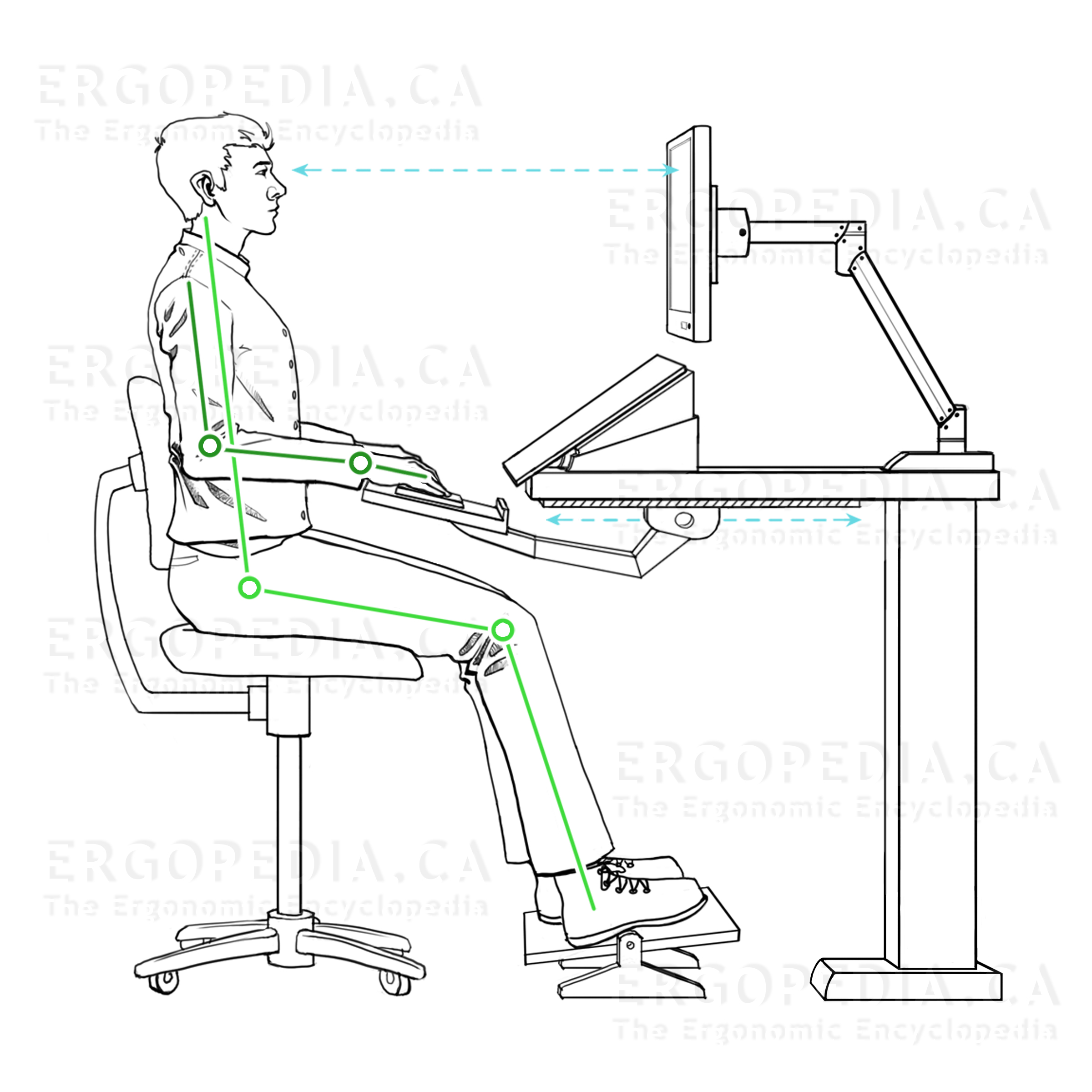Poor Seating
Posture / Incorrectly Configuring (or Failing
to Adjust) the Chair

What is the Correct Seating Posture and Chair
Configuration to Minimize Risk Factors when Seated?
Seat Height: The chair should be adjusted to the height
where the thighs are parallel to the floor, or slightly
inclined towards the knee, with the ball and heel of the feet
in full contact with the ground.
Back Rest: The backrest should be flush against the back
to provide support for the lower back (including lumbar
support).
Lumbar Support: The lumbar support should be adjusted to
the optimal position in the curve of the lower back to ensure
an orthopaedically supported S-Curve in the spine.
Position of Calves and Feet: The angle at the hips and
knees should be slightly greater than 90° to allow the feet to
be slightly forward of the knee of the user, under the
desk.
Seat Pan Depth: There should be 2" of space behind the
back of the leg to prevent the front edge of the seat from
putting pressure on the back of the calf.
Arm Rests (Optional): These can either be on the chair
or attached to the work surface. In no case should the
rests impinge upon or limit access to the workstation.
Arm Placement: The arm should be positioned at a
position close to the line of the torso (as shown in the
picture at right) so the joint where the forearm meets the
upper arm is slightly above 90°.
Arm Rest Height: The height of the rest should be
set such that the shoulders are relaxed, and in the same
position as when the user is standing with arms resting at
their sides.
Arm Rest Width: The supports should be close enough
to the body that there is no strain on the shoulder joint
(typically within 1"-3" of the shoulders).
Why is Improper Seating Posture and Chair Adjustment
a Risk Factor?
If the configuration or usage of the chair is incorrect,
circulation can become impeded and muscle fatigue and cramping
can occur.
If Seat Height is Too Short...
There will be increased pressure on the underside of the
thigh, which has no support.
If Seat Height is Too High...
The knees may impinge on access to the workstation, and
circulation to the legs will be greatly reduced.
If Back Rest is Not in Contact with the Back...
The user will have to rely upon their own resources to
maintain an upright posture, will fatigue at a much faster
rate, and will be prone to adopting poor postures without
realizing it.
If Lumbar Support is Not in Contact with the Small
of the Back...
The user will be unlikely to maintain the proper S-Curve
posture, and will likely start to move to a hunched over
C-Curve posture which will lead to back pain and discomfort.
If Seat Pan Depth is Too Short...
There will be increased pressure across the underside of the
unsupported thighs.
If Seat Pan Depth is Too Deep...
There will be pressure on the back of the calf..
If Arm Rests are Incorrectly Adjusted: Arm rests can be
helpful as they will provide relief to the shoulders and upper
back by supporting the weight of the the arms. Arm rests
at improper heights, depths, or widths will only create
additional postural problems and risk factors for users.
How Close to Ideal does the Seating Posture and Chair
Adjustment have to be to avoid it being a Risk Factor?
There is a fair amount of variance in tolerance to poor
posture throughout the population. However, individuals know
when they are experiencing discomfort, although they may not
always realize that the source is an improperly configured
chair. While many individuals can tolerate a degree of
discomfort before permanent damage is done it needs to be
remembered that discomfort is a warning sign. As such, steps
should be taken to address discomfort as soon as it is
identified. Being proactive in addressing the potential causes
of the discomfort will greatly decrease the risk of developing
pain, which is the way our body tells us that damage has been
done. The line between discomfort and pain is a fine one which
is why it should be avoided.
What are the Symptoms of a Chair which is in the Wrong
Position or Improper Seating Posture?
Symptoms to look for include forced shifting of weight
distribution on the seat pan of the chair to address lower
back pain/discomfort or pressure points on the seat or
underside of the thighs, or a desire to regularly move legs to
relief stiffness, numbness, aches or pains.
How Can the Choice of Accessories or Workstation Help
to Reduce Risk Factors from a Chair which is Incorrectly
Configured or Poor Seating Posture?
Foot
Rests can be added to support the foot and prevent plantarflexion
of the ankle if the feet are too high (i.e. dangling in mid
air, or even if both the ball and heel are not in full contact
with the ground). Foot Rests will also address the potential
for restriction of circulation that can occur if feet are not
properly supported.
Forearm
Supports which attach to the worksurface can serve a
similar role to arm rests on a chair.
Arm
Pads which attach to the arm rests on a chair can
provide extra cushioning and raise an arm rest higher than the
normal range of adjustment allows.
Seat
Support Inserts which can be for the seat pan only or
both seat pan and back can enhance lumbar support, improve
seat pan cushioning, remove pressure points, and address
specific issues such as tailbone sensitivity.
Leg
Supports can elevate the leg for specific situations
where a user needs to elevate their leg to address thrombosis
or other conditions.

